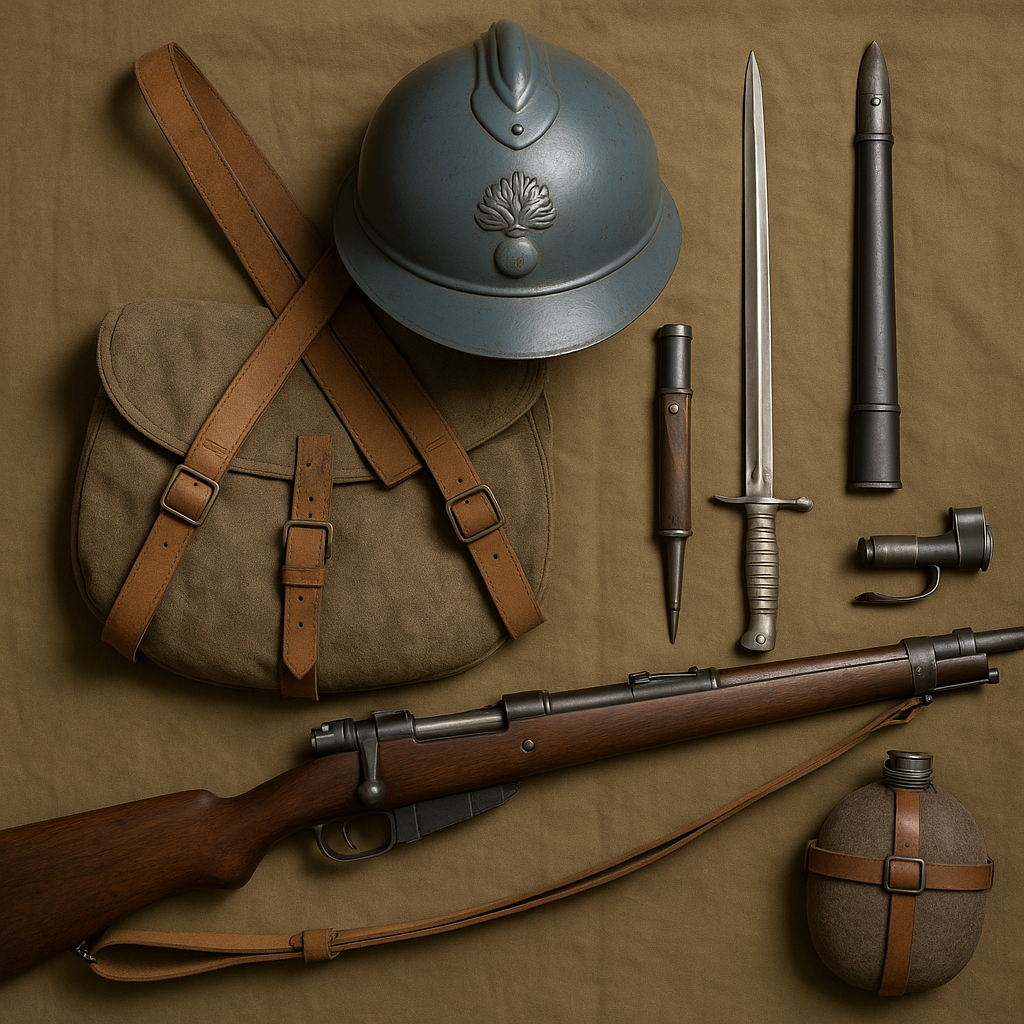
A Complete Guide to French WW1 Soldier Equipment: Bayonets, Rifles & Gear
Published on Jul 01, 2025
A Complete Guide to French WW1 Soldier Equipment
When we think of World War I, we often picture the trench warfare, the mud-caked uniforms, and the brutal hand-to-hand combat that defined the front lines. Among the many armies that participated, the French soldier—or poilu as he was affectionately called—was one of the most iconic figures of the Great War. Central to his survival and combat effectiveness was his gear: a mix of old and new, revolutionary and traditional. This article will take you through the most essential components of French WW1 soldier equipment, including weapons, bayonets, and standard-issue gear, all with a focus on historical accuracy and collector insight.
1. The Standard French Infantry Rifle: The Lebel Model 1886
The backbone of the French army's firepower during the early part of WW1 was the Lebel Model 1886 rifle. Known for its 8mm caliber and revolutionary use of smokeless powder, the Lebel rifle gave French soldiers a distinct advantage in long-range accuracy and reduced visibility.
Key Features:
- Bolt-action rifle with an 8-round tube magazine
- Chambered for 8×50mmR Lebel
- Often paired with the French Lebel bayonet (M1886 Épée Bayonet)
The Lebel was long and relatively heavy, but it became a symbol of the French infantry. Its design reflected the 19th-century warfare mindset but proved reliable during trench fighting. Today, the French Lebel bayonet is a collector's gem, with its long needle-like blade and ornate hilt.
2. The French Lebel Bayonet
Arguably one of the most recognizable pieces of WW1 French militaria, the French Lebel bayonet—also known as the M1886 Épée Bayonet—was standard issue to accompany the Lebel rifle. It featured a cruciform blade designed to pierce deeply, making it particularly lethal in close combat.
Features to Note:
- 20.5-inch cruciform blade
- Brass or aluminum handle grips (depending on the year)
- Steel scabbard
- Unique hook quillon (curved guard) on early models
Collectors often seek bayonets with matching serial numbers on the blade and scabbard. The value of a French Lebel bayonet depends heavily on condition, year of production, and originality.
3. Bayonet Chassepot: A Legacy from the Franco-Prussian War
While not originally a WW1 piece, the Bayonet Chassepot (for the M1866 Chassepot rifle) still appeared in the trenches during early stages of the war due to weapon shortages. Its iconic design—complete with a curved yataghan blade and brass handle—makes it one of the most visually striking bayonets in French military history.
Why It Still Matters:
- Used as a stopgap weapon in early WW1
- Popular among collectors for its pre-WWI craftsmanship
- Often misidentified—adds intrigue and value
Despite its age, the Chassepot bayonet represents a bridge between 19th-century warfare and the mechanized battles of the 20th century. Its reuse in WW1 speaks to the logistical challenges France faced in mobilizing millions of troops quickly.
4. MAS Mle 1936 Rifle: Not Quite WW1, But Often Confused
While the MAS Mle 1936 rifle is technically a post-WWI weapon, it is frequently brought up in collector circles discussing French WW1 equipment. The MAS 36 was introduced between the wars and used extensively in WWII, but many collectors look for early prototypes or transitional models.
What Makes It Collectible:
- Compact and modern bolt-action design
- Chambered in 7.5×54mm French
- Sleek wood finish with practical sights
When searching online for MAS Mle 1936 value, remember that early production models or those with battlefield provenance tend to fetch higher prices. It’s important not to confuse this rifle with its WW1 predecessors like the Berthier Mle 07/15, which also saw heavy use in WW1.
5. Other Essential WW1 French Soldier Gear
Besides rifles and bayonets, French soldiers were equipped with a wide variety of gear that defined their experience on the battlefield.
Standard-Issue Gear Included:
- Adrian Helmet – Introduced in 1915, painted horizon blue
- Horizon Blue Uniform – Designed for camouflage but faded quickly
- Linen and wool puttees – Wrapped around legs for warmth and protection
- Leather Y-strap equipment harness
- Mess kits, bread bags, gas mask canisters
The Adrian helmet, with its distinctive crest and national emblem, is especially prized by collectors. Variants were painted and marked by unit, making each one potentially unique.
6. Tips for Collectors and Enthusiasts
If you're looking to buy or authenticate French WW1 soldier equipment, here are some expert tips:
- Check for serial numbers on bayonets and rifles
- Look for unit markings and regimental stamps
- Be wary of reproductions—especially with Adrian helmets and bayonets
- Invest in condition reports and provenance where possible
- Study original blueprints or manuals to understand variants
Websites like Paddelaters.com offer a curated selection of authentic and historically accurate militaria. Whether you're building a display or researching for historical reenactment, it's important to rely on reputable sources.
7. Historical Significance of French Equipment in WW1
The equipment carried by French soldiers during World War I reflects both innovation and tradition. From revolutionary smokeless powder rifles like the Lebel to old-world bayonets like the Chassepot, French gear tells a story of adaptation in the face of industrialized warfare.
What It Represents:
- Courage of the poilu on the Western Front
- The evolution of battlefield technology
- National pride and resilience during one of history’s most brutal conflicts
As more collectors and historians seek to preserve these items, understanding their function and symbolism becomes more important than ever.
Conclusion: Preserving the Legacy
French WW1 soldier equipment is more than just militaria—it's a tangible link to one of the most defining periods in world history. Whether it's the slender form of the French Lebel bayonet, the iconic curve of the Chassepot blade, or the sleek lines of a MAS Mle 1936 rifle, these items carry stories that deserve to be told, preserved, and passed on.
